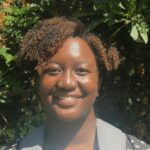On January 28, Amy Briggs and Joy Delizo-Osborne hosted a conversation as a part of SAP’s Coffee & Conversations series entitled A Work in Progress: Dismantling White Supremacy in Our Workplace. The session, recorded here, focused primarily on our journey internally here at Student Achievement Partners (SAP) through a process of learning to identify white supremacy culture in our interactions with one another, and to begin to dismantle it. While we harbored doubts about whether our audience would be interested in the inner workings of our organization, the conversation received a huge response; clearly the topic of dismantling white supremacy culture in our work spaces struck a chord. During the question and answer section of the session, we received a number of questions about how we got to where we are, how Amy responded to receiving feedback about her shortcomings as a leader, how she worked to address the inequitable experiences of folks of color on staff, and how Joy and other BIPOC folks on staff were able to have their voices heard. This blog post, which is the first of several on the topic, will attempt to share more of the specifics of our process, our enduring questions and struggles, and the lessons we are still learning every day.
Lesson #1: You have to start with yourself, your own behaviors, and your power.
Amy: One question I received several times, in one form or another, was: “Where do I start?” I can only speak to this from my own perspective (I am a leader in this organization and identify as a white, cis, straight, female). But I wonder if, and am hopeful that, specifics might resonate for others. Joy and I talked about power in the webinar: how we named where power lived, how I and other white staff ceded power within our span of control, and what we are doing as a team to reimagine our organizational system. All of that is incredibly important. However, really, where I started—and what I have to be attentive to each day— is my own behavior. Behavior (both individual and collective) is what creates and sustains white supremacy culture in the workplace. Before we began this transition, I championed our Diversity, Equity, and Inclusion (DEI) work for almost two years. We had a talented and knowledgeable external partner supporting us. We spent precious time, energy, and money on these efforts. We learned a lot, and we looked at a lot of frameworks, but none of it resulted in real change.
After George Floyd’s murder and our Organization-Wide Equity Pause*, I wrote a list. Not a list of tasks for our internal Equity Working Group or the leadership team, but a list for myself. I called it “personal commitments,” and it is on the 5th page of a purple notebook I stole from my teenage daughter. I look at the list at least once a week. It’s long, but I’ll share a few bullets:
- I will recognize that feeling defensive signals something I need to work on.
- I will learn—and fail—in public.
- I will de-center myself and my white experience.
- I will focus on my actual impact, not defending my intent.
- I will include every person affected by a decision meaningfully.
A starting point (and a good checkpoint) for my list, and for our organizational reflections, has been Tema Okun’s work: https://www.dismantlingracism.org/white-supremacy-culture.html. The work is asking myself regularly if I do these things. Often the answer is no, or not well enough. But also I believe that reflecting on how I show up—as a leader, as a colleague, as a partner, as a mother—and holding my colleagues accountable to the same, is not only the place to start but the anchor for ongoing change.
Joy: My first answer to the question “Where do we start?” is also a question: “Who is ‘we’?” Your positionality matters. Your race, your gender, and gender expression, your role in the organization, your tenure, your formal and informal power within the ecosystem of your organization all matter. So, the first question I would ask myself is…who am I in this organization? Who have I been in this conversation over time? Because whether you know it or not, someone has already been discussing the way your organization’s actions (or inaction) are impacting the work.
Lesson #2: This is happening in your organization, particularly if you are not actively working to counteract white supremacy culture.
Joy: One of the things I think is so important about what we have been through is the fact that not everyone was in the dark about the ways in which white supremacy culture (WSC) was showing up in our work, and in our dealings with one another. We didn’t always have language for it, but white and BIPOC folks alike had been running into, and stumbling over, the roadblocks white supremacy puts in the way of healthy work patterns for years. The roadblocks looked like what folks often characterized as individual shortcomings, like an inability to problem solve, like cults of personality—basically, the roadblocks looked like competitive, white American corporate culture. And they weren’t allowing us as an organization to do our best work. Therefore, moving into really candid conversations about changing the culture meant that we actually had to begin to talk about the ways power was held, wielded, and toxic in our organization.
Our issues are ours, but they aren’t unusual. There isn’t anything that was or is happening at SAP that isn’t happening at your organization if you are not working to counteract WSC. As Dr. Beverly Daniel Tatum has taught us, it is in the air we breathe.
Amy: It’s pretty incredible what we were able to expose once we identified and named power out loud—who has it, who doesn’t have it, who makes decisions, who is always on the receiving end of decisions. The concept of sharing power is not theoretical. It’s a daily process of interrogating who is at the table, how big that table is, and how many chairs get pulled up to it. If you aren’t interrogating power dynamics and those unhealthy roadblocks, you are absolutely recreating power dynamics that stifle collaboration among your team, and—particularly, in a white-majority organization like ours—silence staff of color
Lesson #3: This is a lifetime process. You have to approach the work as a learner, and as a learning organization.
Joy: As you begin the learning process around WSC and the ways you (regardless of race) are likely perpetuating it in the workplace, there are many questions that feel relevant.
For those who feel that they don’t have the power to make or start change:
What influence do you have? What is within your locus of control? What are ways that you can begin to be the change you want to see? A few ways my colleagues and I have done it here at SAP include:
- Modeling the provision of direct, clear, and honest feedback without apology
- Building systems and practices for the work that honor the multiplicity of identities folks bring to the space
- Asking critical questions about problematic practices
- Naming when colleagues (or you) are engaging in detours (and more detours)
For BIPOC, queer and other systematically underestimated, underappreciated, and underrecognized folks:
Shifting an institution’s practices isn’t worth your sanity. Do what it takes to take care of yourself, and consider whether your current organization is a place where you are able to be happy, whole, and supported.
For those who hold positional/formal power:
- How can you, as a leader, signal that you are ready and willing to hear what folks are experiencing, and to take it seriously? How can you signal that you will not allow your ego to get in the way of taking the feedback seriously and doing something about it?
One potential pitfall is not taking the time to follow up on the data you gather formally. During our shift, we realized the surveys were not enough for us to make it clear that we were truly interested in the experiences of our BIPOC staff. We eventually created a number of different forums for everyone to be able to share their input: focus groups, opt-in one-on-ones, and affinity group spaces in addition to surveys. - Are you ready to do something about it? What work needs to happen at the leadership/governance level to allow changes to be made as necessary? Who holds the power, formally and/or informally? Who do you need to get on board to begin to listen with intention to your team?
- Who is modeling what leadership can and should look like in your org? Do those folks model humility and openness to feedback? How so? If not leaders, who can model humility and openness for leadership and get them moving in that direction?
Amy: I appreciated the honest questions and dialogue during our Coffee & Conversations with white educators who are in leadership roles in schools and districts, looking for ideas for how to lead in this space. I have two questions for white leaders to ask themselves, to add to Joy’s list above:
- Are you listening really carefully to your BIPOC team members? Even when you feel defensive? Even when it is hard to hear? Paying close attention to truths I still don’t always see is one of the ways I learn every day.
- Are you modeling the learning stance you hope to see in your team? Specifically, as a white leader, are you failing, and then talking about your failure out loud? A huge part of my identity has been being successful—not just success, but perfect success. Talking about how I screwed up—on our organization-wide Town Halls, for example—is scary. But if I don’t choose authenticity over perfection and courage over comfort, I can never expect anyone else on the team to do so.
To learn more about how these reflections are changing the way we think about our work, keep an eye out for the next post in the series!
*Created by the team at Equity Meets Design. Learn more about their work at equitymeetsdesign.com and https://courses.equitymeetsdesign.com.


















